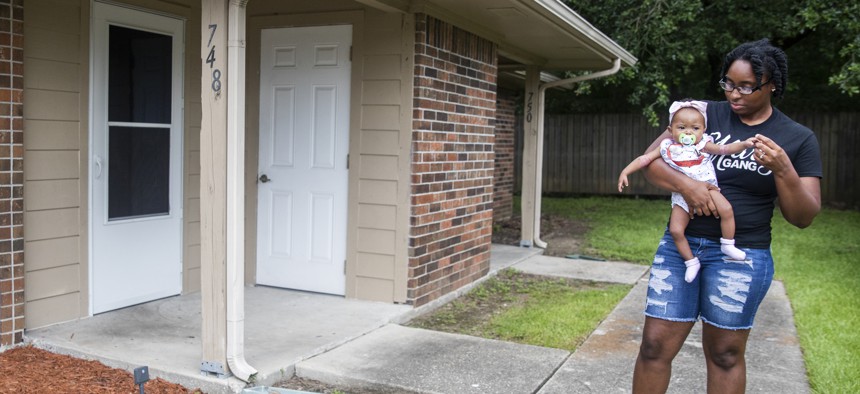States, Localities Distributing Rental Aid at a Quicker Pace

Tyesha Young, who lost her hospital job during the pandemic, holds her baby Jalayah Johnson outside their home in Waggaman, La., Friday, July 2, 2021. More than $7,000 behind on rent, Young hopes a program in Louisiana would bail her out and allow her family to avert eviction in the coming weeks. AP Photo/Sophia Germer
Emergency rental assistance programs have distributed about $3 billion since January, but that accounts for just 6% of the overall aid approved by Congress.
State and local rental assistance programs quickened the pace at which they distributed federal emergency assistance in June—disbursing $1.5 billion in rental assistance to 290,000 households, according to data released Wednesday by the Treasury Department.
But with the looming expiration of the national eviction moratorium at the end of July, housing advocates worry that it’s not enough to help tenants who have fallen behind on rent.
The June figures bring the total amount of federal emergency rental assistance distributed over the last six months up to $3 billion—about 6% of the total amount of federal rental assistance allocated by Congress.
“Even with the improvements, emergency rental assistance has reached only a small fraction of the families who report being behind on rent and at high risk of eviction when the moratorium expires next week,” said Diane Yentel, the president and CEO of the National Low Income Housing Coalition, in an emailed statement. “There remain dozens of states and cities that have distributed little to no assistance to renters in need.”
Congress allocated $46 billion in emergency rental assistance to respond to the economic impact of the coronavirus pandemic, approving two tranches of money in December and March.
State and local governments have struggled to get rental assistance programs up and running from scratch. They’ve had to find staff to administer programs, write their own program guidelines, and advertise the programs to renters in their communities.
The Treasury Department data covers only disbursements of the first tranche of $25 billion in emergency aid, approved in December. But the data highlights where states and localities have been able to implement changes that have helped them speed up deployment of funds, said Rebecca Yae, a senior research analyst at NLIHC.
“There are some especially large increases with high performers and some programs that are really lagging behind,” she said.
Texas is one state that has seen marked improvement since streamlining its rental assistance applications and staffing up to handle the large volume of applications, Yae said.
The state had distributed only $140 million in aid as of the end of May, but distributed $306 million in June alone, according to Treasury Department data.
The nearly 500 rental assistance programs active across the country are trying to get emergency assistance in the hands of vulnerable renters before the national eviction moratorium deadline. The moratorium expires at the end of July and the Centers for Disease Control and Prevention has indicated it will not extend the ban again.
The Treasury Department data shows an improvement in the number of households receiving assistance through state and local programs (156,000 households received $756 million in May).
But the need is much greater than what has been disbursed thus far. The latest Census Bureau data shows that 7.4 million households reported being behind on rent in early July.
“It’s an encouraging sign,” said Will Fischer, the senior director for housing policy and research at the Center for Budget and Policy Priorities. “There is still a long way to go.”
Improving the Process
Facing delays, some government leaders have opted to extend local eviction moratoriums to provide protection for renters while they distribute the funds.
State and local rental assistance programs could also take steps to speed up the distribution of federal funding—such as through proactive outreach to potentially eligible renters (like those on public housing waitlists) or incorporating rental assistance into eviction diversion programs in court.
Another way programs can speed up the process is by streamlining applications for rental assistance, Yae said.
“One of the biggest things that can really slow down applications getting completed and processed is hunting down documentation,” she said.
One way to qualify for rental assistance requires a tenant to show that someone in their household has either qualified for unemployment or experienced a reduction in income or financial hardship due to the pandemic. The Treasury Department issued guidance last month noting that “it may be difficult for some grantees to establish whether a financial hardship experienced during the pandemic is due to the COVID-19 outbreak,” and recommended that applicants be allowed to self certify whether their financial hardship meets that requirement.
Yet only about half of rental assistance programs allow tenants to self certify portions of their application, according to NLIHC.
Andrea Noble is a staff correspondent with Route Fifty.
NEXT STORY: Only 1 in 4 nursing homes are confident they can survive a year





